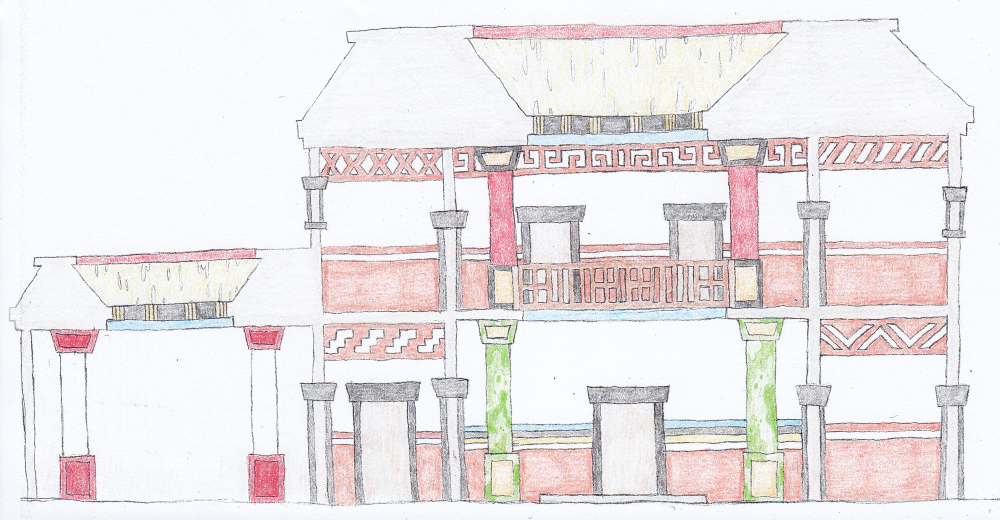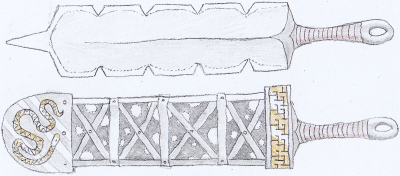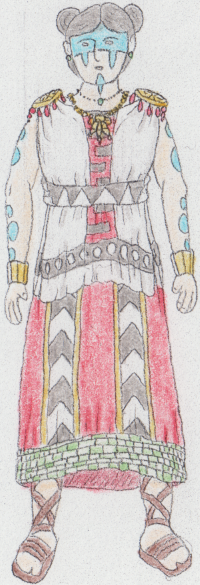Rexans
Rexlas: Rexei
Pakric: Rexú
Dalran: Resakere
Tingrenic: Grix
The rexans1 are native to the Kalis Swamp in western Laxilþía, and the ruling ethnicity of Resak, an empire spanning much of that continent. Their main settlement is Arkis, capital of the empire.
Since then, Úxakkus and his descendants have added more land to their kingdom until the rexans became rulers of much of the continent, though the conquests have slowed down somewhat in recent times.
In the early days of the empire, only the kalsei, júnei and loxei were recognized as specific classes, while the other two didn't appear until later.
Red, white, black, blue and orange dyes are popular.
Jewelry such as necklaces, earrings, labrets and nose-jewels is popular, not only for decoration but as apotropaic devices. Many rexans also paint their faces and body in bright colours.
In the Kalis Swamp and the jungles of Pakróalx, most buildings are built upon stone foundations to prevent them from sinking into the soft soil, while in other places they are included for tradition's sake, if at all. Similarly, all but the smallest shrines are built on top of step pyramids and accessed via steep stairways. Columns and colonnades of various types of stone, including jade and marble, are another common feature of rexan architecture and is generally preferred rather than pakran-style corbelled arches. Plazas, used for both commercial and ceremonial purposes, are common as well.
Rexan commoners generally live in either simple, thatched huts or -especially in larger cities- apartments of varying quality, while warriors who can afford it live in more lavish homes featuring multiple rooms with painted walls and mosaic floors, but only aristocratic families are allowed to inhabit two-story mansions. Merchants live in simple homes but built using materials of noticeably higher quality than most, in order to disguise their often considerable wealth despite low stature.
Mead and diluted wine are the most common drinks, while chocolate beverages are exclusive to the aristocracy.
The army is divided into a number of legions, which are stationed in different provinces depending on perceived vulnerability and current campaigns. Each legion has its own patron deity and ceremonies related to them, some are open to citizens from all walks of life, others are exclusive to those who've already shown bravery and ferocity in battle.
Some of the most prestigious legions are the Crocodile Legion, Eagle Legion, Pardus Legion, Serpent Legion, Wolf Legion.
The rexans1 are native to the Kalis Swamp in western Laxilþía, and the ruling ethnicity of Resak, an empire spanning much of that continent. Their main settlement is Arkis, capital of the empire.
History
Originally one of many small tribes inhabiting the Kalis Swamp, the rexans were originally vassals of Gúþirda, one of the kingdoms of the Jatrilnúxans to the south, and their chiefs were often involved in their masters' wars with rival jatrilnúxan kingdoms. One such chief, Úxakkus, became especially successful along with his brother Kós, and eventually planned to overthrow the jatrilnúxans. Kós -fearing their masters' wrath if the rebellion proved unsuccessful- alerted the king of Gúþirda and fought with him against the rexans, but Úxakkus managed to defeat them.Since then, Úxakkus and his descendants have added more land to their kingdom until the rexans became rulers of much of the continent, though the conquests have slowed down somewhat in recent times.
Society
Rexan society is divided into five classes: aristocracy (kalsei) which includes the royal family, priests and priestesses, generals and engineers; a middle class (takrei) of warriors; commoners (júnei), which make up the bulk of the population; merchants (talexei), who despite their low stature are often quite wealthy and often serves as spies; and slaves (loxei).In the early days of the empire, only the kalsei, júnei and loxei were recognized as specific classes, while the other two didn't appear until later.
Culture
Apparel
Traditional rexan clothing is made almost exclusively out of cotton, with woolen or flaxen clothes more closely associated with the other ethnic groups within the empire. Men usually wear loincloths and a kind of shirt or cloak, while women's clothes consist of either a long, sleeveless dress, or a kind of short-sleeved blouse and a skirt. Footwear is mostly worn by nobility or (for commoners) during festivals, as such clothing doesn't last long in the swampy heartlands of the empire.Red, white, black, blue and orange dyes are popular.
Jewelry such as necklaces, earrings, labrets and nose-jewels is popular, not only for decoration but as apotropaic devices. Many rexans also paint their faces and body in bright colours.
Art
Architecture
Rexan architecture is heavily influenced by jatrilnúxan and -to lesser extend- pakran styles, and mansions, temples and other public buildings are fairly uniform in all but the most remote parts of the empire, though homes of commoners vary quite a bit depending on local climate and resources.In the Kalis Swamp and the jungles of Pakróalx, most buildings are built upon stone foundations to prevent them from sinking into the soft soil, while in other places they are included for tradition's sake, if at all. Similarly, all but the smallest shrines are built on top of step pyramids and accessed via steep stairways. Columns and colonnades of various types of stone, including jade and marble, are another common feature of rexan architecture and is generally preferred rather than pakran-style corbelled arches. Plazas, used for both commercial and ceremonial purposes, are common as well.
Rexan commoners generally live in either simple, thatched huts or -especially in larger cities- apartments of varying quality, while warriors who can afford it live in more lavish homes featuring multiple rooms with painted walls and mosaic floors, but only aristocratic families are allowed to inhabit two-story mansions. Merchants live in simple homes but built using materials of noticeably higher quality than most, in order to disguise their often considerable wealth despite low stature.
Cuisine
Main article: Rexan Cuisine Rexan diet consists mostly of flat bread and porridge, vegetables, cheese, fish, the meat of pigs, goats, crocodiles and turtles, poultry, eggs and olive oil. Popular spices include chili peppers, vanilla, garlic and saffron.Mead and diluted wine are the most common drinks, while chocolate beverages are exclusive to the aristocracy.
Language
Main article: RexlasScience and technology
Calendar
In the rexan calendar, a year is 384 day long, divided into twelve months, each further divided into four weeks, and each week is eight days. Each month is dedicated and named after one of the four elements in rexan mythology, so each year has a First, Second and Third Fire Month, for example. The days of the week use a similar system, with each week starting on a First Air Day and ending on Second Earth Day.Mathematics
Rexans use a numeral system based on twenty and uses three symbols, two slightly altered letters and a special one in the shape of a stylized flower, representing zero. This is similar to the system used by the Pakrans and Jatrilnúxans.Religion
Main article: Rexan Polytheism Rexan religion is polytheistic in nature, incorporating rexan deities and those worshipped by other groups alike, with many of the latter being syncretized to fit more easily within the rexan pantheon. Animal and human sacrifices feature heavily in rexan religion, the latter which are usually performed through ritual combat in amphitheaters, which are also a source of entertainment for the citizens of the empire.Warfare
The rexan army consists mostly of infantry and -to lesser extend- archers and spear throwers, with cavalry being limited to certain provinces. Cotton armour (similar to our world's linothorax) is common for soldiers of lower ranks, with added metal scales and decorative elements for higher ups, while generals wear scale armour.The army is divided into a number of legions, which are stationed in different provinces depending on perceived vulnerability and current campaigns. Each legion has its own patron deity and ceremonies related to them, some are open to citizens from all walks of life, others are exclusive to those who've already shown bravery and ferocity in battle.
Some of the most prestigious legions are the Crocodile Legion, Eagle Legion, Pardus Legion, Serpent Legion, Wolf Legion.
1Original icelandic: Rexar, singular: Rexi
Related Organizations
Related Locations










Comments